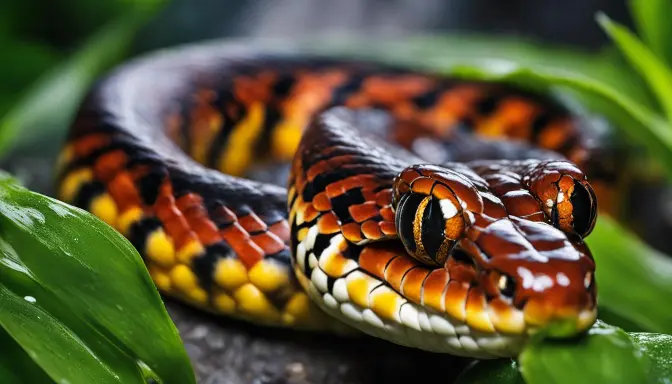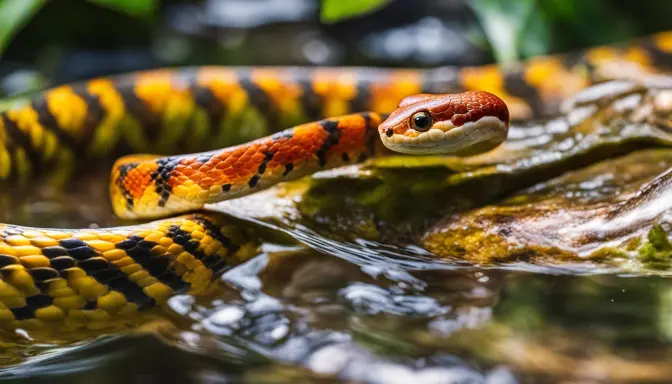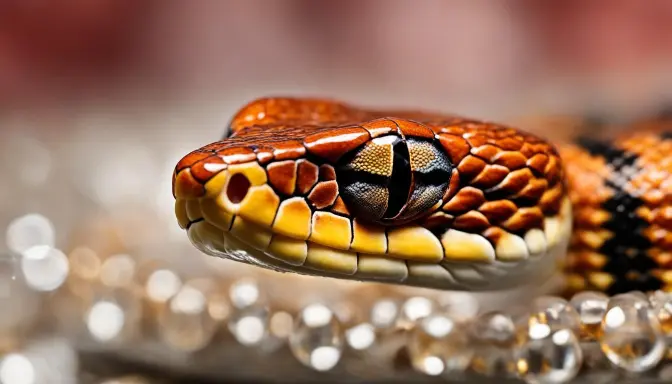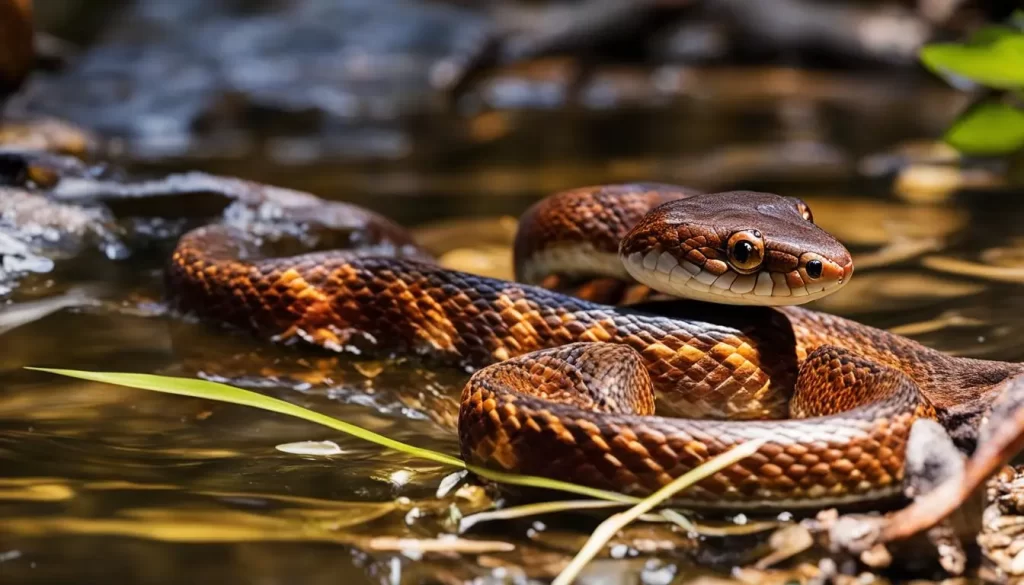Corn snakes, scientifically known as Pantherophis guttatus, are popular reptile pets known for their vibrant colors and docile nature.
However, there is some debate about whether these snakes have a preference for water or not. Let’s explore the facts and shed light on the aquatic behavior of corn snakes.
Key Takeaways:
- While corn snakes do not have a strong preference for water like some aquatic snake species, they still require access to clean water in their enclosure.
- Corn snakes obtain most of their water from their prey and rarely drink water directly.
- In captivity, it is important to provide a shallow water dish for the snake to soak in if it chooses to do so, but it is not essential for their survival.
- By understanding the natural behavior of corn snakes and providing a suitable environment, reptile enthusiasts can ensure the proper care and happiness of their slithery friends.
- Unlike aquatic snakes, corn snakes are not designed to spend prolonged periods in the water and their interactions with water are brief and infrequent.
Natural Habitat of Corn Snakes
When considering the natural habitat of corn snakes, it’s important to understand their origins. These snakes are commonly found in the southeastern United States, where they thrive in a diverse range of environments.
From forests to grasslands to agricultural areas, corn snakes have adapted to various habitats.
In their natural habitat, corn snakes are skilled climbers, often spending their time in trees or burrowing underground. While they may come across water sources such as ponds or streams, corn snakes do not have a strong affinity for water.
Adaptation to Different Environments
Corn snakes have proven their adaptability, allowing them to survive in a wide range of environments. They can navigate through different terrains and climates, making them versatile creatures in the wild.
These snakes have evolved to blend in with their surroundings, making them excellent hunters. Their ability to camouflage helps them catch prey like rodents, which is their primary source of water.
Habitat Requirements in Captivity
When it comes to keeping corn snakes as pets, it’s crucial to provide a suitable habitat that mimics their natural environment.
This includes a secure enclosure with plenty of hiding spots, suitable climbing structures, and a controlled temperature range.
In terms of water, while corn snakes primarily obtain hydration from their food, it is still essential to provide a shallow dish of water in their enclosure for soaking if desired.
This helps maintain proper humidity levels and gives the snake the option to hydrate through soaking if needed.
In Summary
- Corn snakes are native to the southeastern United States and can adapt to different habitats.
- They are skilled climbers and spend time in trees or burrowing underground.
- While corn snakes may encounter water in their natural habitat, they do not have a strong preference for it.
- In captivity, it is important to provide a suitable habitat that includes a shallow water dish for hydration.
Hydration Needs of Corn Snakes

When it comes to the hydration needs of corn snakes, it’s important to understand that these reptiles require water for their basic physiological functions, just like any other living creature.
However, their hydration requirements are met primarily through their prey, which consists mainly of rodents.
Corn snakes do not have a significant need to drink water directly. Instead, they obtain most of their water intake from the bodies of their prey.
In captivity, it is still essential to provide a shallow water dish for your corn snake to soak in if it chooses to do so.
This allows them to engage in natural behaviors and maintain proper hydration levels. However, it is important to note that a water dish is not essential for their survival, as they can meet their hydration needs through their food.
The presence of a water dish provides an additional source of water and allows the snake to regulate its own hydration levels as needed.
How Much Water Do Corn Snakes Need?
Unlike some other species of snakes, corn snakes do not have high water requirements. Their unique biology and natural habitat make them well-suited to survive with minimal water intake.
The amount of water a corn snake needs varies based on factors such as its size, age, and overall health.
In general, providing a shallow water dish filled with clean, fresh water is sufficient to meet the hydration needs of a captive corn snake.
Key Points:
- ✅ Corn snakes obtain most of their water from their prey, rather than drinking directly.
- ✅ A water dish in their enclosure allows corn snakes to engage in natural behaviors and regulate their hydration levels.
- ✅ Providing a shallow water dish with clean, fresh water is sufficient to meet the hydration needs of a corn snake.
Behavior Around Water

Corn snakes, despite their name, are not particularly fond of water and do not possess strong swimming abilities.
Unlike aquatic snakes, corn snakes are not designed for prolonged periods in the water. Their interactions with water are typically brief and infrequent.
While they may occasionally enter water sources in their natural habitat, such as ponds or streams, it is important to note that these instances are driven by specific reasons rather than a genuine enjoyment of water.
Even though corn snakes are not aquatic by nature, they may enter water for various reasons. One common reason is hunting.
When prey, such as frogs or small fish, seek shelter in water, corn snakes may temporarily venture in to catch them.
Another reason for their interaction with water is to find relief from heat. In hot environments, corn snakes may dip into water sources to cool down.
However, it’s important to remember that these behaviors are the exception rather than the norm for corn snakes.
They do not require swimming or constant access to water to thrive. In fact, corn snakes are highly adaptable to dry environments and are designed to conserve water efficiently.
As long as they have access to clean water in their enclosure for hydration, corn snakes can live comfortably without significant exposure to water.
Providing Water for Corn Snakes in Captivity

When it comes to caring for corn snakes in captivity, providing access to clean water is essential for their overall well-being.
While these snakes do not have a strong preference for water like some aquatic species, it is still important to include a water dish in their enclosure.
The water dish should be large enough for the snake to comfortably soak in, but shallow to prevent any risk of drowning.
It’s crucial to regularly clean and refill the water dish to ensure cleanliness and freshness. This helps maintain a healthy environment for your corn snake.
Water Dish for Corn Snake
- Choose a sturdy water dish that cannot be easily tipped over.
- Ensure that the dish is made of a safe material, such as ceramic or glass, to avoid any potential harm to the snake.
- Place the water dish in a secure location within the enclosure, making sure it is easily accessible for the snake.
Corn Snake Water Requirements
Corn snakes do not have high water requirements compared to some other reptiles. Most of their hydration needs are met through their food, which consists primarily of rodents.
However, providing a water dish ensures that your corn snake has the option to drink if desired.
It is also advisable to use a reptile-safe water conditioner to remove any chlorine or harmful chemicals from tap water.
This helps maintain the water quality and prevents any potential health issues for your snake.
Conclusion
In summary, the aquatic behavior of corn snakes is not a defining characteristic of their species. While they may encounter water in their natural habitat, corn snakes do not have a strong preference for water like some aquatic snake species.
They primarily obtain moisture through their prey, and providing a water dish in their enclosure is important for their overall well-being.
By understanding the natural behavior of corn snakes and meeting their basic hydration needs, we can ensure the proper care and happiness of these fascinating reptiles.
It is crucial to provide a shallow water dish that is large enough for the snake to soak in comfortably but not deep enough to pose a drowning risk.
Regular cleaning and refilling of the water dish will ensure cleanliness and freshness.
So, while corn snakes may not be avid swimmers, they still require access to clean water for their overall health.
By creating a suitable environment and taking care of their basic needs, we can provide the best possible care for our slithery friends.
Frequently Asked Questions
Q: Do corn snakes like wet?
A: Corn snakes do not particularly enjoy being wet. They prefer a dry environment with a moderate level of humidity, typically around 40-50%. Excessive wetness can lead to skin issues such as scale rot.
Q: Do corn snakes like baths?
A: While corn snakes don’t necessarily need baths, they may benefit from occasional soaking especially during shedding to help loosen the skin. However, this should be done carefully and infrequently, ensuring the water is shallow and the snake is supervised.
Q: Do corn snakes need water in their tank?
A: Yes, corn snakes need a bowl of fresh water in their tank. The water bowl should be large enough for them to soak in if they wish, but shallow enough to prevent drowning. The water should be changed regularly to keep it clean.
Q: Can you give a corn snake tap water?
A: You can give a corn snake tap water, but it’s advisable to let the water stand for a day before use or use a water conditioner to remove chlorine and other chemicals, which can be harmful to snakes.
Q: What water is best for corn snakes?
A: The best water for corn snakes is clean, chlorine-free water. If using tap water, ensure it is treated or left to stand to remove chlorine. Alternatively, filtered or bottled water can be used.
Q: Can corn snakes drown?
A: Yes, corn snakes can drown if they are unable to get out of deep water. It’s important that their water bowl is shallow enough for them to easily climb in and out without risk of drowning.




